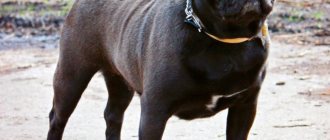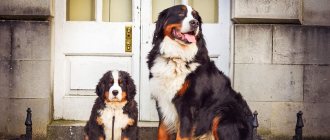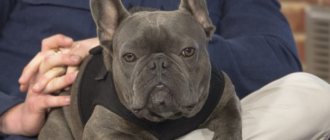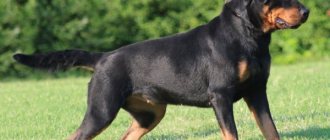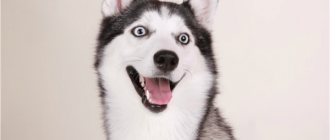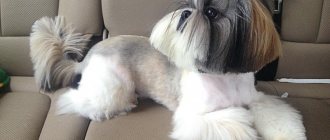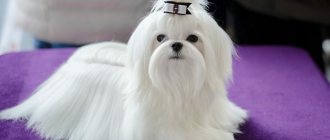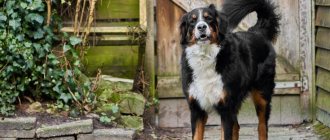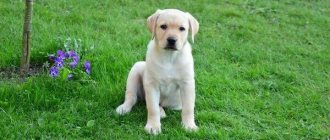The dachshund is an ancient hunting breed of dog.
It has only its own appearance with short legs and an elongated body.
Like real hunters, dachshunds are brave and resilient.
They know how to think logically, have intelligence and cunning.
As companions, dogs are cheerful and very sociable.
Photos of what newborn puppies look like
Puppies are born blind and deaf . React to pain, cold and touch. In the first week of life they only sleep and suckle. Healthy dachshund puppies feel dry and warm to the touch.
Babies cannot yet regulate their body temperature, so their place needs to be warmed up.
At three weeks of age, puppies are already active enough to explore their home..
Rules of care
A dachshund must have its own corner for sleeping and relaxing. Below we will talk about how to care for a dachshund puppy - this is very important so that it grows up healthy and joyful. There is nothing complicated in the rules on how to care for a dachshund - you will need ordinary care and attention:
- Daily walks in the fresh air are mandatory - your pet needs to move a lot and lead an active lifestyle;
- Caring for puppies of this breed involves purchasing toys and setting aside their own corner where they can relax or play with their treasures. If there are no toys, get ready for chewed-up shoes and furniture - horror stories are often told about puppies, but they happen to those owners who did not think to stock up on toys;
- Your pet should have a place to sleep - it should be a warm corner without drafts or excessive movement. Lay there a soft, cozy mattress with a removable cover.
- Don’t forget to comb it with a special rubber glove or brush;
- Caring for puppies of this breed does not involve washing them too often - this disrupts their natural skin acid-base balance. In the first six months, avoid swimming altogether - this is recommended by experts;
Don't forget to clean your dog's ears and teeth
- Trim your claws using a nail clipper - in adulthood, such dogs take care of their claws on their own, grinding them down;
- Clean your ears with cotton swabs soaked in hydrogen peroxide;
- Teeth cleaning is carried out with a special dog toothpaste with the taste of meat and a special toothbrush - this is necessary to avoid the appearance of tartar.
When they open their eyes
Puppies open their eyes at 10-13 days . One eye may open before the other. After a week, the cub's gaze will be able to focus. At first, dogs only distinguish between light and dark.
Objects are seen dimly. During this period, puppies should be protected from bright light.
Good vision appears in the fourth or fifth week.
Dachshund work
To maintain shape and normal weight, walk longer outside, engage in active games with a stick, ball, or puller. For the best owners, there is a wonderful activity that develops the hunting instinct, scent, cunning and independence - “working a dachshund on the blood trail.”
Such events are held by nurseries, and your pet will be happy to participate. A blood trail is laid along which the dog searches for prey; this is a common activity for “working” dogs.
If you want to actively participate in exhibitions, as well as breed this breed, you will need a lot of knowledge and help in raising and maintaining your pet.
Dimensions and weight
Puppies are born quite large. Their weight in relation to the mother's weight is 7-8%. Dachshunds are growing very rapidly.
After a week they weigh twice as much as at birth, after two weeks - three times as much.
By the age of one month, the weight of puppies increases 7-8 times. One and a half month old babies weigh ten times more than newborns.
Tips for choosing
When you decide to adopt a dachshund puppy, you must first consider offers from trusted breeders, ask the dog’s pedigree, and to be sure, see the parents, their behavior, and character. Most likely, the dog will become like them. At the same time, it is advisable to check the conditions in which the animals grow and what they eat. A healthy puppy has smooth fur, a straight back, clean eyes, and normal teeth. The chosen dachshund should not be too aggressive or lethargic.
Expert opinion
Anna Abramenko
An avid dog lover. Experience in veterinary medicine since 2009.
Ask a Question
By picking up a puppy before 2 months, the owner undertakes its vaccination. If the dachshund cub is older, you need to ask for a vaccination certificate.
A typical mistake of future dog owners is that they choose a puppy who sits alone in the corner when everyone else is frolicking. They feel sorry for him, not suspecting that he may have health problems. It is advisable to choose a dachshund that is not very different in behavior from its brothers.
How it develops day by day in the first month
| Age | Stages of development |
| 1-10 day | Puppies are blind and deaf, but have a developed sense of smell and touch and respond to touch. They sleep and suckle their mother. |
| 4 day | Already knows how to find the mother’s milkiest nipples, knows her smell |
| 5 day | The nose is stained |
| Day 8 | The puppy weighs twice as much as at birth |
| 10-14 day | Eyes open, can crawl, growl at other puppies, can suck from a bottle |
| 14-21 | The puppy begins to hear, walk, play, and may begin to eat solid food. |
| 21-30 | The first teeth appear. The kids are actively exploring the territory. For the first time they begin to wag their tail. The mother can leave the cubs for a long time. |
Puppies after birth
Newborn dachshunds have weak and elastic ligaments and muscles. This is necessary so that they are less injured. The eyes are still closed, the ears are pressed very tightly to the head. They feed on mother's milk, and in the first days on fatty colostrum. They squeak and fidget from time to time, but once they are full and warm, they quickly calm down.
From the 10th day, the puppies' eyes open and their hearing becomes more acute. The color of the iris is usually blue and slightly cloudy. Small dachshunds are already moving more, their activity is growing every day, as is their body weight.
By 14 days they try to interact with each other. Clumsy attempts at play and biting are necessary for primary skills and reflexes. Clutching his littermate's ear with his weak jaws, the puppy understands how much force is needed to hurt.
How it develops from 1 to 12 months
| Puppy age | Stages of development |
| 1 month | The two main activities are eating and sleeping. Puppies grow quickly, gain weight, and recognize bright objects. From two weeks of age they can move independently |
| 2 month | Teeth appear, it is possible and even beneficial to give something solid as food, something that can be chewed, for example, a carrot. The active development of living space begins. Puppies need supervision. |
| 3 month | Character is formed. The first walks begin. The puppy tries to walk on a leash, gets the basics of training |
| 4 month | Awareness of one’s “social” role, one’s place in the “pack.” The first attempts to demonstrate a leadership character. |
| 4-8 month | The puppy may run away from its owner |
| 5-6 month | Walking increases |
| 6-10 month | Puberty begins. The bitch is in her first heat, and the males are marking their territory. |
| 8-9 month | All permanent teeth grow, relationships of subordination and leadership are consolidated |
Advantages and disadvantages of dachshunds
Dachshunds are popular in many countries. Most of their owners are in favor of this breed and will not agree to exchange it for another. Energy, artistry, courage - this is not a complete list of the advantages of these dogs. Dachshunds can be a good assistant for a hunter. Their short legs and flexible skin allow it to crawl into a narrow hole and reach the rodent. Dogs swim well and can bring back shot birds.
Intelligence, quick wit, resourcefulness, and devotion make this dog an excellent friend for a single person or a family with children. Despite their excellent character, dachshunds are touchy, jealous, do not like to be left alone, and require constant attention.
Due to its long body, the Dachshund often has problems with the spine, especially if it is not fed correctly and has become fat. Short legs do not allow the dog to jump like other breeds, and jumping from heights is also contraindicated for them (dogs can easily get injured).
The dachshund is a dog with a complex character. Some owners note that trying to train her is the same as raising a teenager. Sometimes she shows character and goes against the rules. Patience and understanding of the characteristics of a dachshund are the key to a good relationship with a dog.
How to care?
Caring for a puppy involves taking care of its health.
This includes proper feeding, timely deworming, and timely vaccinations. Walks are a must, especially with such an active dog as a dachshund .
Raising a dog should be handled by one person, it is advisable to immediately make it clear who is boss in the house. Rules of behavior are taught as early as possible and strictly adhered to, without making any concessions. Violence cannot be used as punishment.
You can express your dissatisfaction with the dog’s behavior by temporarily not paying attention to it, dachshunds are smart, they will understand everything:
- The puppy should have its own toys, clean warm bedding, and a place to feed.
- The pet's nails are trimmed as needed.
- Wipe the eyes with a warm, damp cloth.
- It is better to clean your ears by instilling a special lotion. It will contribute to the accumulation of dirt on the inside of the ear, from where it can be easily removed with a napkin.
- There are special brushes and toothpastes for teeth.
- The wool is wiped with a terry towel or a soft brush.
- Wash puppies if necessary and only with water without chemicals.
Character
All dogs of this breed are characterized not only by the ability to seek contact and mutual understanding with the owner - for it this is a necessity. Therefore, it is extremely important on your part to provide not only adequate care for the puppy, but also to find a common language with him. Otherwise, the puppies become vindictive, unfriendly and spiteful.
For all their devotion, representatives of this breed often commit various unpredictable actions. They tend to dig holes and behave so actively that the eyes of those present begin to ripple. Curiosity and curiosity are all that can be said about the main character traits of this breed. A puppy dachshund needs an eye and an eye - otherwise, it can create absolute bedlam in the apartment in a matter of minutes. That is why proper education and training is so important for them.
Dachshunds are curious and inquisitive
The Dachshund puppy is endowed with a sharp mind, he is independent and quick-witted - at the same time he has incredible charm. With attention on your part, very soon the dog will become the favorite of the whole family, but it is important not to spoil it.
If you don’t like communication too much, then don’t get yourself a breed like a dachshund—care involves constant contact with it. Your puppy's lively character and temperament require implementation - remember this.
A few words should be said about small children - dachshunds literally adore them, becoming devoted friends. All kinds of games of hide and seek and chase, hugs and races - your child gives a dog of this breed everything he needs in terms of emotions, communication and active recreation.
First walks
The first walks usually begin after the end of quarantine after vaccination (two weeks after vaccination).
For walks to go well, the puppy must:
- know your master well;
- respond to your nickname;
- be able to walk on a leash;
- know the basic commands “fu” and “come”.
In the first days, it is advisable to walk along one route so that the puppy gets comfortable.
CAREFULLY!
It is better to avoid contact with adult dogs; they may not calculate their strength and injure the puppy even during play.
At first, young pets are walked frequently, but not for long, so that the puppies do not get tired emotionally and physically.
Choosing a collar for your pet
In addition to all the accessories listed, you need to choose the right collar for your dog. For a dachshund, metal attributes are not a suitable option. Despite all the reliability, they put pressure on the neck, and as a result, wearing them turns into torture for the pet. It is also not recommended to buy too thick, soft models.
The best option is collars with a thickening in the middle. To walk your dog, you additionally need to buy a roulette leash. Recommended length is 3-5 m.
What to feed for the first three months
For the first week and a half, puppies only suckle their mother . The role of the person at this time is to ensure that all the cubs receive enough milk so that the stronger ones do not push the weaker ones aside.
Weak babies should be transferred to the rear, milkiest nipples of the bitch. They take the babies carefully, picking them up from below with their palms under their sides, or under their chest and butt. Well-fed puppies sleep, and hungry ones crawl restlessly.
From 10-12 days of age, puppies can be fed (if necessary) . Prepare a mixture of boiled cow's or goat's milk, diluted 1/3 with water or a weak infusion of tea, and a raw chicken egg (one egg per 0.5 liter of milk). The temperature of the mixture should be 28-30°C.
The cubs are bottle fed. When the puppies' eyes open, they are taught to lap the mixture from a saucer. With a small litter and a sufficient amount of milk from the mother, complementary feeding begins on the 20th day.
They feed the babies 4-5 times a day in small portions, making sure that the puppy’s bellies do not swell too much . Overeating is one of the main dangers to a dachshund's health; an overloaded stomach can lead to sagging of the back and curvature of the shoulder blades.
3-5 days after the start of complementary feeding, milk and curd mixture, oatmeal and rice porridge, mashed boiled vegetables and meat are introduced into the puppies’ diet.
Long-term feeding with mother's milk strengthens the puppies' body and increases resistance to diseases.
From two months of age, raw cartilage is occasionally given, and from 4-5 months, soft beef bones can be given.
For proper development, your dog needs vitamins and mineral supplements. To avoid rickets, you need phosphorus and calcium. The norms and form of mineral supplements are determined by a veterinarian.
Once a day, add a teaspoon of fish oil and crushed eggshells to your food..
Your pet should always have clean water in his bowl.
Natural diet
should contain different foods - sources of protein, fats, carbohydrates, vitamins and minerals. Follow this rule and do not try to greatly diversify your dog’s diet.
Suitable:
- stringy meat (chicken (if there is no allergy), turkey, lamb without fat, beef - in large pieces);
- sea fish, boneless, scalded;
- cereal porridge in water or broth (rice, buckwheat), steamed rolled oats;
- vegetables and fruits (raw, grated or put through a blender, with the exception of cabbage, stew it);
- low-fat fermented milk products (yogurt, cottage cheese; cheese - as a reward);
- tendon bones (clean teeth, strengthen jaw);
- eggs (boiled or raw yolk).
How to feed correctly and how often
Puppies are fed six times a day in small portions. Everything in the bowl must be completely eaten and the bowl must be licked clean. If this does not happen, the portion is reduced.
After eating, the puppy should want to play, and not lie exhausted from the amount of food he has eaten.:
- At three months, feeding frequency is 3-4 times a day
- At six months - 2-3 times a day
- After a year - 2 times a day
Sample menu for a dachshund puppy:
- breakfast - a mixture of milk and cottage cheese;
- second breakfast (four hours later) - meat broth with vegetables;
- lunch - porridge (oatmeal, buckwheat, rice) with milk or meat broth;
- dinner - small pieces of meat with vegetables, or with porridge;
- at night - fermented milk products.
The only sure way to know whether a dog is developing correctly is to weigh it regularly. The first two weeks this is done once every two days, then once a week.
There is nothing to worry about if the puppy:
- regularly gains weight;
- sleeps after eating;
- has a healthy appetite.
What food to feed a dachshund with health problems
- Obesity: if it is not diabetes or thyroid disease, put your pet on a low-calorie natural diet (meat, vegetables and dairy) or a ready-made diet for overweight dogs.
- Allergies: hypoallergenic lines of industrial feed are suitable; or choose those natural products to which your pet will not have a reaction.
- Gastritis: easily digestible foods (chicken), steamed, slimy soups and porridges or food for dogs with sensitive digestion.
Vaccination schedule and which ones should be done
The first vaccination is usually given by the breeder with a mandatory note in the puppy’s veterinary passport. Before vaccinations, puppies should not walk outside or interact with other animals.
A prerequisite for the first vaccination is two stages of its completion.:
- 2 months - first vaccination against plague, enteritis, hepatitis, adenovirus.
- 2.5 months - revaccination with the previous vaccine.
- 6-7 months - re-vaccination against leptospirosis.
- One year - third vaccination and plus against rabies.
- Then the dog is vaccinated again annually.
Before vaccinations, deworming must be carried out . The first such procedure is performed by the breeder when the puppies are three weeks old. The second deworming is done when the puppies are 1.5 months old, two weeks before the planned vaccination.
In order to prevent a possible allergic reaction to a medication in time, it is better to do the vaccination under the supervision of a veterinarian.
IMPORTANT!
Vaccination is given only to healthy animals.
If the puppy gets sick, the vaccination is postponed to another time.
Briefly about the main thing
- Living in the same house with a dachshund, we can definitely say that with proper care, she will delight you and your children with her presence for many years.
- The dachshund is not demanding when it comes to nutrition, but has an increased appetite; it is necessary to control the pet’s weight.
- The lifespan of a dog depends on proper care and preventive measures.
- The breed requires regular exercise and vigorous long walks.
- The dog is not prone to diseases if vaccinated in a timely manner.
- To prevent breed diseases of the spine and joints, it is necessary to regularly visit a veterinarian.
How to bathe properly?
Puppies that are on their mother's milk should not be bathed . The bitch cleans them herself. Particularly dirty areas of babies can be wiped with a damp, then dry cloth.
It is imperative to take care of the cleanliness of the bedding in the puppy's nest. At first, the mother dachshund takes care of it herself. She licks the cubs and eats their feces.
Until the age of five months, puppies are not washed to avoid skin irritation . In case of emergency, wash only with water and overnight.
Origin story
Even in Egyptian cave paintings, a dog similar to a dachshund was depicted in all its glory; finds and mentions of this are in historical museums. This means that this is an ancient breed that has been loved and respected for a long time.
Although the hunting breed is not famous for its long legs like hound dogs, it is no less fast and agile. She will easily overtake any animal, and if it climbs into a hole, she will take out a trophy and present it to the owner.
The dachshund has no equal in burrow hunting for rodents. Previously, when it was expensive to own a pack of hounds, and such a privilege was enjoyed by the rich, dachshunds were owned by amateur hunters or self-sufficient people.
The weight and height of hound breeds was great, and keeping such an animal was also expensive. German breeders set to work, trying to reduce their size and create a unique breed capable of burrow hunting.
As a result of all these experiments, in the 16th century, such a breed as the “hunting marriage” was born. Its short legs were initially considered a defect, but after looking at the results of their work in practice, they began to carry out breeding selections to improve the quality of this breed.
Marriages a few years later began to be called dachshunds, and their standard was established in 1870. Today there are many dachshund standards in each country, one of them is adopted by the London Kennel Club, and the other by the FCI in Russia.
While the formation and standard of the breed was taking place, dachshunds changed their size, height and weight. They became more elongated and short-legged. The breed was depicted in artists' drawings, and famous people, such as Napoleon Bonaparte and many Russian figures, got dachshunds as life companions.
This is the first breed that has many varieties, dachshunds are divided by size, weight, and they also differ in the length of the coat and the animal, endurance and hunting ability.
Dachshunds are an ancient breed, known since the time of the Egyptians. Only wealthy people could afford it for hunting. Despite her interesting appearance, the baby is very agile and runs fast.
The first individuals had quite a lot of weight and height compared to modern dogs. They very cleverly caught small rodents and tracked them in burrows.
The Germans immediately realized what a unique huntress they had at their disposal and set to work to improve the breed. The initial goal was to make the dachshund small so that it could easily not only track the animal in a hole, but also get into it.
But time passed and in the 16th century, breeders selected “hunting marriage” in an attempt to correct the situation. After some time, the Brak was recognized as a real breed of dachshund, and in 1870 the standard for these cuties was established.
At the moment, there is a standard adopted in London by the Kennel Club and another in Russia adopted by the Canine Federation (FCI)
The dachshund, whose breed standard has changed for a very long time, has retained its main feature - the hunting instinct, which is quite strong.
Modern dachshunds are interesting, independent, loyal to the owner and attentive to family members, if well cared for - they can even live up to 15-18 years. Now the dog is more often a couch potato, but it’s not so easy to forget his roots; it’s clearly expressed in his behavior and character.
Baby teeth and cleaning
Baby teeth appear at three weeks of age. They are sharper than permanent and very fragile. Baby teeth grow completely by 5-6 weeks.
It is not always possible to judge by the bite of baby teeth what a dog's bite will be like . You need to carefully monitor the change of your puppy's teeth, since baby teeth that do not fall out in time can cause the formation of a malocclusion.
To prevent this from happening, you need to give the puppy something hard to chew on, like a carrot. Sometimes a loose baby tooth cannot fall out (especially baby canines) and interferes with the proper growth of permanent teeth.
In this case, they have to be removed. Playing with a puppy with a strong, but not dense rag can help in this matter; this will be the most painless way to remove a “stagnant” tooth .
Permanent teeth begin to replace baby teeth at 12-16 weeks. The process of changing teeth can be very painful for puppies.
The dog is taught to brush its teeth from the age of two months. First, use your own finger, wrapped in several layers of bandage. Apply paste to the bandage and wipe the outside of the teeth.
In the future, you can try using a baby brush . The procedure takes no more than 10 minutes. If the puppy endures the test, he should be rewarded.
Household and dog safety
To ensure the comfort of the dachshund and family members, a house is prepared for the pet. The litter in it should not contain small parts. Place soft material and a diaper on top. The outer fabric is changed as it gets dirty. The dachshund needs to have privacy.
Dachshund house
Wires, electrical appliances, and poisonous indoor plants are removed from the puppy’s access area.
The dog does not show aggression towards children. But, if a child accidentally hurts the puppy, he may react by growling or even biting. Children are explained that they cannot play with a dog like a toy.
IMPORTANT! The dachshund has a weak back; children should not be allowed to sit on the dog or push it down the steps. For the same reason, the dog should not be lifted by the withers, pulled strongly on the leash, or allowed to stand on its hind legs.
How to train and what commands to teach
When starting to train a dachshund, you need to remember that this is a hunting dog and its hunting instincts are an unconditioned reflex..
The desire to track and pursue an animal, “plowing” the area in search of scented prey - all these are natural, ineradicable characteristics of the dachshund.
During training, unconditional irritating factors should not be allowed. The dachshund will not obey if it smells game or finds a mink.
Some training rules:
- the command must be spoken once;
- the command should always sound the same. It is necessary to decide how to say “fu” or “no”, “bring” or “fetch”;
- You need to praise your dog for success.
First basic commands:
- "to me" . You can start learning at home, at home. When the puppy comes running when called, you need to praise him and give him a treat. If the pet does not respond to a command spoken twice, you must bring it to the place from which it was called and repeat the command. If the training takes place outside, there is no need to run after the puppy, because it will look like a fun game. You need to turn around and pretend to leave. But you can’t let one puppy go far;
- "it is forbidden" . It is necessary to immediately prohibit doing unacceptable things, for example, chewing shoes. To satisfy natural needs, it is better to offer special toys for dogs;
- "sit" . When learning this command, you can lightly press on the dog's croup while holding the treat above his head. You can give the reward only when the puppy sits down.
Breed Features
These dogs are loyal to their owner, smart, and easy to train. They show courage, so the dachshund can be called a good guard. The dachshund's voice is so loud that it is comparable to the barking of large breed dogs. The dachshund is not picky when it comes to food.
Dachshunds behave with dignity and require appropriate treatment. They are very delicate, calm and reserved, but only on condition that they receive enough attention, love and affection from the owner.
If the owner of the dog does not see the dog as a person, he will receive in response to such an attitude a lot of troubles that only a dog is capable of. First of all, it is constant barking. The dachshund may chew things and will not respond to comments or commands.
The dachshund has one more feature. Despite its small stature and short legs, the dachshund is an excellent hunter and swimmer. And this breed was bred specifically for this purpose. She is active, resilient, able to withstand great physical activity and overcome considerable distances. The main prey of dachshunds are badgers and foxes.
Description, character and photo
There are three types of dachshund:
- smooth-haired (they are also called short-haired);
- long-haired;
- Wire-haired.
Based on size, dachshunds are also divided into three types:
- standard dachshunds (20-25 cm at the withers, weight up to 9 kg);
- dwarf (up to 5 kg in weight);
- rabbit (up to 15 cm at the withers, weight – up to 3 and a half kilograms).
The appearance of the dachshund puppy is noticeable: a disproportionately elongated muscular body and short legs. This squat dog has a noticeable waist. The puppy's head is elongated, narrowed towards the nose, there is a well-defined hollow between the superciliary ridges, and the nose is dark brown or black. On both sides of the head there are floppy ears that drop to the middle of the cheekbones. The eyes are dark brown or marbled.
A dachshund's mouth normally has 42 teeth. The paws are wide and have claws. The claws are brown. The dachshund's tail is saber-shaped and droops down. Color: from straw to red-brown. Less commonly, the color is black with yellow markings, there are coffee shades with tan markings and even blue and white.
The dachshund has a sociable character. The puppy requires maximum attention. Receiving it, he becomes a true friend to the owner. Faithful and devoted. Recklessly brave when it comes to protecting the owner or rushing to carry out his command. If ignored by the owner, it can turn into a sullen and vindictive dog.
Every Dachshund puppy has great potential - this breed:
- independent;
- active;
- playful;
- charming;
- smart.
If a person who decides to own a dachshund does not know how to show emotions, is withdrawn, uncommunicative, then he should think about some other breed.
Development: newborns, 1, 2 months and up to six months
Approximate weight standards:
- newborn puppy -200-300 grams;
- 1 month – kilogram (formation of reflexes, development of communication skills, adaptation of vision and hearing to the environment);
- 2 months – 2 kg (no fear, period of socialization, beginning of training);
- 3 months – 3-3.5 kg (checks teeth, increased activity);
- 4 months – 4-5 kg (training can be more complicated);
- 5 months – 5-6 kg (self-assertion, obedience only to the leader);
- 6 months – 6-7 kg (fear of unfamiliar objects may appear).
How to toilet train
To toilet train a puppy, you can’t do without a special absorbent diaper..
If the baby ignores the diaper and chooses another place for his needs that is more suitable from his point of view, you need to moisten a piece of cloth in its puddle and place it on the diaper, and wash the place chosen by the puppy with soap and vinegar to eliminate the smell.
The puppy will be guided by the smell, so it is better not to wash the diapers at first. Gradually accustoming your pet to a tray (a special “dog” one with low sides), you need to put his usual diaper in this tray.
If you place the tray in the hallway in front of the front door, then take it outside in front of the dog, you can gradually accustom him to using the toilet outside the house . It can be difficult to train a dachshund to relieve itself outside.
The puppy can endure it until he returns to his usual place home. In this case, a used puppy diaper will help, which you will have to take with you at first. You can also increase the walking time, walk in those places where the pet was able to leave its “marks”.
Maintenance in the house and apartment
For a puppy, be sure to buy a tray, prepare a blanket or blanket, a piece of fur for a bed, and toys. The only problem that the owner of a dachshund puppy who wants to keep him in an apartment or house may encounter is the animal’s increased physical activity (walk more often) and the desire to dig (walk more often and arrange outdoor games on the street).
Preparing the site and necessary purchases
Buy:
- two bowls (for water and food);
- litter tray;
- soft bedding;
- sunbed;
- house for place;
- harness;
- collar;
- leash;
- reusable diapers;
- nail clippers or guillotines;
- shampoo;
- combs and brushes;
- towels;
- toys.
Litter box training and walking
The tray must be very large so that the pet feels free in it. As soon as the puppy has eaten, put him in the toilet, and if he has done his business there, prepare a treat and praise him. Dogs do not bury their excrement, so you must be able to clean up the litter box on time. For a male dog, buy a tray with a post.
When the puppy wants to urinate, he sits down. Have time to lay down a newspaper or diaper, which you then put in the tray. Tray training requires a lot of patience. But it is much easier to teach him to ask to go to the toilet outside. But this will happen after three or four months. Until this time, it is advisable not to take the dog outside often.
Training your dog to be home alone
For many dogs, being separated from their owner and being alone at home is a real stress. You need to gradually accustom your pet to the fact that he will not always be in the company of his loved one. When you get home, play with the puppy and then feint. For the puppy to see, put on your outerwear again and jingle your keys. The puppy will get used to it and will not react negatively.
Your pet will gradually get used to parting if you often go out and then return after a short time, increasing the time of parting each time.
Toys
To prevent the owner’s slippers from becoming the pet’s favorite toy, you need to purchase a latex or rubber toy for the puppy. Balls with squeakers and regular balls to teach the puppy to perform the “Fetch” command, a pumpkin of cabbage or corn and other improvised means for playing - everything will come into use. The main thing is that the puppy plays in the company of the owner, because he really loves attention and active games with other puppies or people.
When weaned from mother
The longer puppies are fed their mother's milk, the stronger and healthier dogs they will grow up to be..
In the fifth week, the puppies are gradually separated from their mother, first the strongest, then all of them in turn.
At this time, the puppies already have their first baby teeth, and they can try to eat solid food . The bitch's milk supply also decreases.
It is necessary to wean from the mother not in an instant, but by alternating mother’s milk and new liquid food. Then the transition will happen painlessly.
Organization of a recreation area
Before bringing your dachshund into your home, you need to hide electrical wires and shoes. And to keep an animal at home, wash the floors. A small pet, trying everything on its teeth, can become infected with some kind of infection or poisoned. It is necessary to remove indoor plants out of reach of the dog.
For your pet to rest, it is recommended to set up a special area in one of the corners of the apartment. The animal should be kept away from heating radiators and drafts.
A dachshund will only be able to rest comfortably in close proximity to people.
Error type: "Forbidden". Error message: "The request cannot be completed because you have exceeded your quota." Domain: "youtube.quota". Reason: "quotaExceeded". Did you add your own Google API key? Look at the help.
Check in YouTube if the id PLH53slWA60RffuPxzdJUXRB-7vbSaA6Ii belongs to a playlist. Check the FAQ of the plugin or send error messages to support.
How to tell a boy from a girl
Gender is determined by physiological characteristics by examining the puppy’s tummy. Females will have only papillae and a navel on their belly, while males will have a barely visible genital organ.
Just don’t rush into determining the sex, since newborn babies’ genitals are still poorly defined; there’s no need to take the puppies away from their mother again, so as not to irritate either the mother or her cubs.
Males that have already reached the age of six months are distinguished by the habit of marking territory and raising their paws when urinating.
At 6-9 months, females may already have their first estrus.
Determining gender by appearance or behavior is problematic; all puppies at a young age are active and playful.
Training and temperament
Dachshunds have a complex, sometimes capricious character. It is not so easy to teach this dog to follow the rules, but this is not due to his lack of intelligence. On the contrary, the dachshund has an innate sense of self-esteem, intelligence, pride, and independence that do not allow them to obey.
The future owner of a dachshund should expect that his pet can be spontaneous and unpredictable. A dog can be taught to follow commands, but sometimes it prefers to live by its own rules.
They begin to raise a dachshund from the moment they are weaned from their mother. Dog breeders note that the best age for a dog to do this is 2 months.
You need great patience and respect for the dog for it to become a good friend and protector. A sequence of actions, a reward system, and calm handling are a necessity when training puppies. When teaching the rules of behavior, life in a family, an apartment, you should not hit or shout at your pet. This can result in reverse aggression and resentment of the dog. The dachshund senses the owner’s mood well; simple reprimand has a positive result. The main thing is to make it clear that there is one master in the house, and she must follow his rules and carry out orders.
The hunting instinct pushes dachshunds to dig the ground. Dogs can turn a garden plot into a training ground after hostilities. It is advisable to be careful when there is a folded blanket on the sofa, and before sitting down, check if there is a pet under it.
Small puppies are gradually accustomed to the toilet and sleeping place. There must be a specially designated area for this. If the dog's owner wants her to follow his rules, for example, not to jump on the sofa or bed, then other family members do not need to allow her to do this either.
Expert opinion
Anna Abramenko
An avid dog lover. Experience in veterinary medicine since 2009.
Ask a Question
Dachshunds have inexhaustible energy and excitement. They were bred to search for prey and endowed with all the qualities of a hunting dog. On the street they chase birds or small animals. Despite its small stature, this animal will not be more afraid of the dog than itself and will fight back.
The energy of a dachshund is not for everyone. It will appeal to people who prefer an active lifestyle. The breed may look like a caricature due to its short legs, long body, and ears. But the animal becomes a good friend and protector for the owners. Read about other dogs with short legs in this article.
?
How to choose?
The reputation of the nursery and breeder is important. You need to look at the puppies’ parents, their appearance, get acquainted with their merits and pedigrees.
Puppy selection criteria:
- thoroughbreds must have a mark on the belly or right ear;
- eyes - clear, brown, blue are allowed only for marble ones;
- bite - scissor bite;
- pink gums and tongue;
- ears are rounded, without folds;
- the back is flat without sagging or humps;
- the tail continues the line of the back, without creases;
- paws are not thin;
- the nose and claws are black, brown - in dachshunds the color is brown;
- The color of puppies is darker than that of adult dogs. With age, the color becomes less saturated. For black and tan dachshunds, the greater the contrast between the color of the tan and the base coat, the better. White markings are not allowed (except marble). The absence of tan in the black color is a sign of impure blood.
The puppy should be well-fed, but not fat, with clear skin without signs of disease.
NOTE!
You can check whether a cub is brave or timid, aggressive or calm, by making a little noise by rattling something in front of the puppy.
The puppy's reaction will tell you about its character.
The best option is if the baby did not snuggle, was not afraid, but showed interest and curiosity..
It is imperative to watch how the puppy moves, whether the movements are free.
Unacceptable elements of appearance and behavior:
- cowardice,
- aggressiveness,
- endless barking,
- tallness,
- high rear (croup higher than withers),
- excessive squatness,
- blue eyes (allowed only for merle-colored dachshunds),
- ears are too folded or pointed,
- sagging or hunchbacked back,
- frail chest,
- underdevelopment of muscles,
- clumsy movements, waddling,
- sparse coat with bald patches,
- the fur is too rough
- a tail without hair or, conversely, too long hair on the tail in the form of a brush,
- incomplete teeth, misaligned jaws.
The appearance of a puppy in the house is associated with endless worries, time, emotional and material costs . But all your efforts will pay off handsomely if you manage to raise a healthy, friendly, balanced dog.
What to do if fleas appear?
When your pet constantly itches and behaves restlessly, you can suspect that it has fleas. In this case, it is necessary to carefully examine the animal. If there are a lot of insects, then they are easy to detect. In small numbers, fleas manifest themselves in feces in the form of brown spots, including on the litter.
Today, special anti-flea products are effective. They are presented in a wide variety, so when choosing, it is recommended to consult a veterinarian and carefully study the instructions for their use.
A common and gentle method of flea control for dachshunds is bathing with a special shampoo. The product is applied to the dog, left on it for a while, and then washed off in the shower. Drops or sprays are indicated as a preventative option. They are effective and have a long-lasting effect. Such drugs are allowed to be used for adult dogs.
After treating the animal, it is important to vacuum the living area and carry out wet cleaning with insecticidal preparations. If there were a lot of fleas, then it is possible that they managed to lay eggs in secluded places. Therefore, after a while, the treatment of the animal will have to be repeated. After you manage to get rid of the insects, it is recommended to change the litter.
Our dog handlers
dachshund training specialists
Alexander Chaplygin Dog psychologist-zoopsychologist
Experience: 37 years Read more..
Ekaterina Panova Dog psychologist-zoopsychologist
Experience: 34 years Read more..
Yaroslav Morozov Dog psychologist-zoopsychologist
Experience: 25 years Read more..
Lada Yurtseva Dog psychologist-zoopsychologist
Experience: 21 years Read more..
Victoria Fox Dog psychologist-animal psychologist
Experience: 14 years Read more..
Ekaterina Budkina Dog psychologist-zoopsychologist
Experience: 13 years Read more..
Evgeniy Bravinsky Dog psychologist-zoopsychologist
Experience: 17 years Read more..
Vitalia Bravinskaya Dog psychologist-zoopsychologist
Experience: 10 years Read more..
Kira Ageeva Dog psychologist-zoopsychologist
Experience: 19 years Read more..
Evgenia Zuber Dog psychologist-zoopsychologist
Experience: 12 years Read more..
Tatyana Melnikova Dog psychologist-zoopsychologist
Experience: 10 years Read more..
Alexey Melikhov Dog psychologist-zoopsychologist
Experience: 22 years Read more..
* Check with the managers for the possibility of a specific specialist visiting the area you specified. If the desired dog handler does not work in your area, then we can offer you another specialist from the above.
At what age do you start training?
Puppy training must begin from the very first days
the presence of a dog in your home. Because already from infancy, the puppy must learn the rules of behavior in your house, what is allowed and what is forbidden, how to behave with all family members, even the smallest and oldest, what he can play with and what he can’t, where to go. toilet and much more.
And we are talking, first of all, about the proper upbringing of a dachshund puppy, and you can start training and learning commands when the puppy is completely comfortable in your home. As a rule, one week is enough. By this time, the puppy is already filled with curiosity and is diligently exploring the world around him. If, after this time, the puppy remains fearful and does not make contact well, then it is better to seek help from a dog handler-animal psychologist, because This behavior is not typical for puppies of this breed.
When can you start training with a dog handler?
The beginning of the puppy's training coincides with the time of the first exit to the street. When the first two vaccinations have already been done, the quarantine (lasts 7-14 days, depending on the vaccination) after them is over. It is not at all necessary to train your puppy only outside; the first sessions are best done at home, where there are fewer distractions.
Often new puppy owners worry that training from the first days will be excessively stressful for the dog. This is only possible if outdated, rigid methods are used, and with the right approach, training from the first days will, on the contrary, be very useful, since it allows you to immediately establish contact
with the puppy and build a trusting relationship.
You can start raising a puppy from the first days of its appearance in your home, and training and classes with a dog handler can begin simultaneously with the start of walks, when quarantine ends after the second vaccination.
Why you don't need to wait up to 6 months
You often hear that dachshunds, like other dogs, cannot be trained before 6 months, because training is stressful. This opinion remains from the times of outdated methods based on cruel coercion and intimidation of the dog. Unfortunately, there are still plenty of dog handlers using similar techniques today. But fortunately, science does not stand still and modern techniques make it possible to train a puppy from the first days in a new home. Therefore, you should not wait until your Dachshund puppy develops unwanted behavior; you can start training much earlier.
